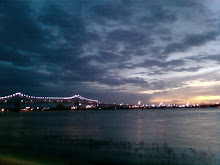
Directions: riverbound to right, lakebound to left, downriver to top, upriver to bottom. The large round structure to right is the Louisiana Superdome, with the smaller New Orleans Arena attached directly adjacent. The major portion of the Central Business District (CBD) is located to the right of this image.
Overview:
The freeway traversing from left to right is the Pontchartrain Expressway. Riverbound it carries the US 90 Business and secret I-910 designations; lakebound it carries the I-10 designation. The diagonal portion of the interchange is the I-10 mainline. The upriver leg of the interchange constitutes South Claiborne Avenue, designated US 90. Claiborne Avenue passes through the interchange on a viaduct and comes to earth under the I-10 viaduct which leaves the interchange structure in the downriver direction, located within the formerly tree-lined median of Claiborne Avenue.
Earhart Boulevard crosses left to right at the bottom of this image, and Poydras Street passes left to right along the downriver side of the Superdome. Ramps connect to Poydras from the I-10 diagonal section.
Timeline:
Late 1940s: The New Basin Canal, a once prominent but now disused shipping canal, is filled in by the state. The canal right of way will eventually be used for the Pontchartrain Expressway lakeward from the future megachange.
Middle 1950s: The Claiborne Avenue viaduct is constructed to grade separate that major thoroughfare from the adjacent rail yards, as part of the Union Passenger Terminal (UPT) project. This viaduct also overcrosses Poydras Street and Calliope Street (now Earhart Blvd.), two throughfares which are upgraded by the city in future years into major arteries to provide improved access to downtown. A left exit/entrance ramp is provided from the viaduct to access Poydras from Claiborne downriverbound/to Claiborne upriverbound. This ramp remains to-day.
ca. 1956: The Pontchartrain Expressway is completed from Airline Highway to the megachange vicinity, terminating at Claiborne Avenue. This includes the construction of a six-lane bridge (the "Dorgenois Street" overpass) over the rail line that serves as the approach to the UPT. (This bridge is located on the far west end of the interchange just before the merge with I-10 lakebound.) The first of the interchange ramps, providing access to and from the freeway from Claiborne, are placed into service.
1958: The elevated Pontchartrain Expressway viaduct along Calliope Street is opened along with the first GNO Bridge. This extends the freeway through the interchange and leads to the opening of more ramps from Claiborne Avenue. The freeway is constructed to crude 1950s standards throughout.
ca. 1961: I-10 is designated along the Pontchartrain Expressway from this interchange lakebound, while the freeway riverbound is designated US 90B.
1967-69: The I-10 Claiborne Avenue viaduct is completed in the area. Connections to the existing Claiborne Avenue viaduct in both directions are made at that facility's downriver end. For a while, I-10 uses the antiquated ramps at the Claiborne interchange to make the connection between the Claiborne viaduct leg and the Pontchartrain Expressway leg of its New Orleans routing.
Late 1960s: The city widens Poydras Street, turning the roadway into a principal arterial feeding the CBD and accommodating six lanes of traffic. This widening clears valuable CBD real estate which will later be exploited for the petroleum fueled office tower boom of the 1970s and early 1980s.
Mid 1970s: The diagonal "flyover" ramps for the I-10 mainline are completed, providing a superior connection for interstate through traffic. Ramps are provided to and from Poydras Street from this segment, feeding into the widened arterial and providing convenient access to the soon to be opened Louisiana Superdome. Other ramps within the Claiborne interchange are modified to provide easy access to the Superdome.
1975: The Superdome, home of the New Orleans Saints, is completed and opens for gameplay.
1981: A major reconstruction of the antiquated Pontchartrain Expressway elevated alignment commences. This project is completed in 1997 and primarily involves improving the freeway to modern standards, adding additional capacity, reconfiguring the downtown entry and exit ramps (not pictured), and constructing a new elevated cross-river HOV lane. The centerpiece of the project is the construction of a parallel Miss. River bridge, doubling the capacity of the 1958-completed GNO Bridge.
1988: The second Mississippi River bridge (not pictured) opens.
1997: Two elevated ramps, the most recent omponents of the 'megachange' to be added, are completed. These sweeping ramps link I-10 westbound to US 90/Claiborne Avenue and US 90B, and US 90B to I-10 eastbound. A former left exit providing direct access from WB I-10 to the S. Claiborne Avenue viaduct is removed; however, its counterpart ramp, providing access from downriver-bound Claiborne to I-10 EB, remains.
Also, a new ramp linking the Superdome complex to US 90B riverbound, via Howard Avenue, opens. This ramp connects to an existing loop ramp that links upriver-bound Claiborne Avenue with the riverbound US 90B freeway.
August 2005: Yours truly observes crews replacing the last remaining sections of 1950s era guardrail on the elevated US 90B freeway with modern type barrier. The "Dorgenois Street" overpass, however, remains to this day in its original 1950s configuration, complete with one very nasty inside lane merge on lakebound that was never rectified.
September 2005: The megachange viaducts and the adjacent elevated freeways serve as a staging area/refugee herding area during the 8/29 Crisis of National Despair.



No comments:
Post a Comment